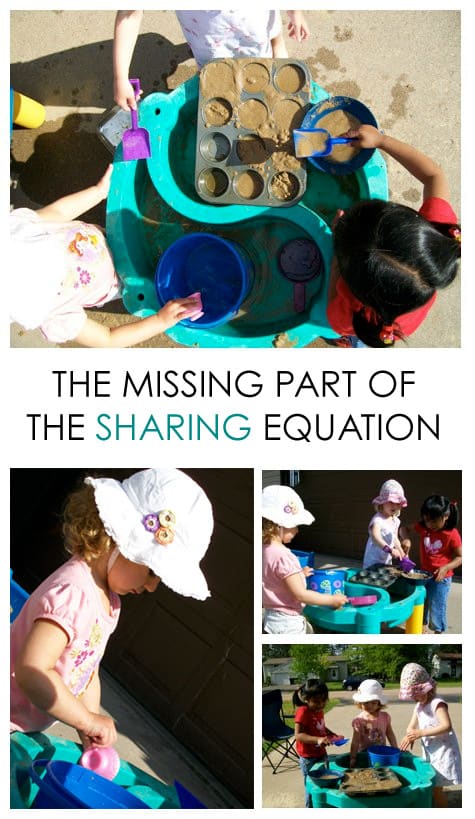
 Does "sharing" often go sour at your house? Many of us have only been taught one part of the “Sharing Equation.” I know from reading 101 parenting articles that when my daughter comes to me tattling, “She won’t share,” that I needed to redirect her back to her sister. I ship her back into the situation with this scripted tattle-redirect:
Does "sharing" often go sour at your house? Many of us have only been taught one part of the “Sharing Equation.” I know from reading 101 parenting articles that when my daughter comes to me tattling, “She won’t share,” that I needed to redirect her back to her sister. I ship her back into the situation with this scripted tattle-redirect:
“That’s so sad. It sounds like you’re talking to the wrong person, try talking to [name] instead.”
How often has this approach actually worked for you? We know kids need to resolve their own issues. We know we don’t want them relying on us to fix every problem that arises.
Yet, whenever I would try this approach, the kids’ conversation always fell flat.
The situation would escalate to yelling, pushing or even fighting.
My friend Emily, who is a teacher, gave me a priceless toddler tip on a family vacation. Our two strong-willed children had been continually arguing over a toy. She calmly walked the children through a guided interaction. My jaw dropped in amazement as the children (in my opinion at the time) magically came up with “terms of agreement” for the toy. The best part? Later in the week, I heard the kids successfully work through an argument without involving parents. Hot dog! Success.
Below we are going to discuss ways to successfully facilitate the second component of the Sharing Equation.
This is the simple statement that will turn your house around:
“How many minutes until I get a turn?”
In an ideal situation the conversation should go something like this (also see the "real-life" tips below):
Jimmy: Can I play with that?
Anna: No.
Jimmy: How many minutes until I get a turn?
Anna: Six.
Jimmy: Ok. (Walks away to tell mom or dad how long to set the timer for)
Why this works
Arguments are rarely about the toy, they are about control. Young children are constantly experimenting with ways to garner more control over their lives. Just think about how many directives we give them: when to eat, sleep, sit still ... don’t touch this, do that. By refusing to share, the child is showcasing control over an item. By teaching your children to use this dialog, you'll be offering both kids the opportunity for control.
- Jimmy is giving Anna control. She gets to decide how many minutes. This gives the child with the toy a feeling of authority, so they are more willing to engage.
- Jimmy is also asserting control over his own situation. He is no longer asking if he can play with the toy. His statement evolves to, “How many minutes until I get a turn?” This implies he will play with the toy and that he knows he deserves a turn.

How to teach your children this process
- Offer guidance: The next time one of your kids comes to you and says, “Anna won’t let me play with that.” Use the re-direct statement above, but add an offer of help at the end, “That’s so sad. It sounds like you’re talking to the wrong person though. Would you like some help talking with her?”
- Don’t get suckered in: When you walk over the other child is likely going to fly off the handle with some sort of explanation with the assumption they are in trouble. Don’t get involved in the details of the argument. Calmly reply, “Jimmy has something to say to you.”
- Kick-start the convo: Look your child in the eyes and say, “Ask Anna how many minutes until you get a turn.” Your prompt might get Anna worked up again, keep your patience when asking her to be quiet. Again, encourage the child to ask the minutes question.
- Guide the interaction: The first time a child asks, “How many minutes,” the other child might pick a crazy number like a million minutes. At that point step in and say, “What’s a better choice? Three or seven?” If they reply with a million again, don’t punish them for not participating in your little parenting experiment. Simply reply, “Three it is then. I’ll set the timer,” and walk way.
- Be the time keeper: Set a timer on your phone or on the kitchen stove. When it goes off, give the child with the toy the opportunity to hand it over on their own. If they don’t react to the sound of the timer itself, make an observation rather than giving a directive, “Anna, I hear the timer.”
Here’s the key to this working long-term without your involvement:
You can tell the child what to say, but do NOT speak on their behalf.
The child MUST repeat the statement and assert themselves.
 Real life tips
Real life tips
- You’ll probably need to facilitate the interaction a few times before you see the kids rolling with it on their own.
- Children as young as two or three can use this process. The statement can be reduced to the simple question, “Minutes?”
- If the child offers an inappropriate number of minutes the first few times you practice the interaction, offer them a choice between two appropriate time frames. If this behavior continues long-term though, start setting the time automatically to two minutes and say, “That is not an appropriate time. I’ll set the timer for two minutes since you didn’t make a choice.”
- When dealing with toddlers keep the time frames smaller (2-5 minutes), younger kids can have a wider range (2-15 minutes), and older elementary kids can handle nearly any time frame (2-60+ minutes).
- If the child still will not relinquish the toy upon hearing the timer, consider taking alternative measures, like a short break.
Redirecting children who tattle on their siblings or another child is only part of the Sharing Equation. When I look back, of course the conversations failed. I was asking children in a heated situation to calmly figure out a solution without giving them the tools (words) to do so. Everything is 20/20 in hindsight my friends.
Tattle Redirect + Minutes Statement = Happy Kids & Mom
If your kids respond in a way not addressed up above, let me know. Emily has used this approach with countless daycare toddlers and kindergartens over the years. It still works with my girls who are in elementary school. If you get stuck in a scenario you can’t resolve, leave a comment below and we’ll work through it together.

This post is dedicated to my friends (and fellow moms) Heidi & Emily. Heidi is an amazing mom who exhibits a calm sense of inner peace when managing the chaos of four children. The loving tone she showcases with her children is something I strive for on a daily basis. Emily is my mom go-to source when parenting seems to be getting the best of me. She's introduced me to Love & Logic, this minute statement, and a million other things. Her years as a mom and as a teacher give her priceless experience. I am thankful to have both of these women as a part of my life. XO
Find additional inspiration...
 |
 |
 |
 |
 |
|
 |
|||||
Share this post with your friends. Pin it!







